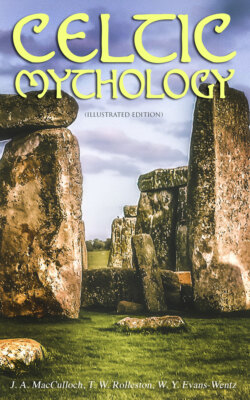Читать книгу CELTIC MYTHOLOGY (Illustrated Edition) - T. W. Rolleston - Страница 81
На сайте Литреса книга снята с продажи.
2.
ОглавлениеAn old bear cult gave place to the cult of a bear goddess and probably of a god. At Berne—an old Celtic place-name meaning "bear"—was found a bronze group of a goddess holding a patera with fruit, and a bear approaching her as if to be fed. The inscription runs, Deae Artioni Licinia Sabinilla.663 A local bear-cult had once existed at Berne, and is still recalled in the presence of the famous bears there, but the divine bear had given place to a goddess whose name and symbol were ursine. From an old Celtic Artos, fem. Arta, "bear," were derived various divine names. Of these Dea Artio(n) means "bear goddess," and Artaios, equated with Mercury, is perhaps a bear god.664 Another bear goddess, Andarta, was honoured at Die (Drôme), the word perhaps meaning "strong bear"—And- being an augmentive.665 Numerous place-names derived from Artos perhaps witness to a widespread cult of the bear, and the word also occurs in Welsh, and Irish personal names—Arthmael, Arthbiu, and possibly Arthur, and the numerous Arts of Irish texts. Descent from the divine bear is also signified in names like Welsh Arthgen, Irish Artigan, from Artigenos, "son of the bear." Another Celtic name for "bear" was the Gaulish matu, Irish math, found in Matugenos, "son of the bear," and in MacMahon, which is a corrupt form of Mac-math-ghamhain, "son of the bear's son," or "of the bear."666
Similarly a cult of the stag seems to have given place to that of a god with stag's horns, represented on many bas-reliefs, and probably connected with the underworld.667 The stag, as a grain-eater, may have been regarded as the embodiment of the corn-spirit, and then associated with the under-earth region whence the corn sprang, by one of those inversions of thought so common in the stage of transition from animal gods to gods with animal symbols. The elk may have been worshipped in Ireland, and a three antlered stag is the subject of a story in the Fionn saga.668 Its third antler, like the third horn of bull or boar, may be a sign of divinity.
The horse had also been worshipped, but a goddess Epona (Gaul. epo-s, "horse"), protectress of horses and asses, took its place, and had a far-spread cult. She rides a horse or mare with its foal, or is seated among horses, or feeds horses. A representation of a mare suckling a foal—a design analogous to those in which Epona feeds foals—shows that her primitive equine nature had not been forgotten.669 The Gauls were horse-rearers, and Epona was the goddess of the craft; but, as in other cases, a cult of the horse must have preceded its domestication, and its flesh may not have been eaten, or, if so, only sacramentally.670 Finally, the divine horse became the anthropomorphic horse-goddess. Her images were placed in stables, and several inscriptions and statuettes have been found in such buildings or in cavalry barracks.671 The remains of the cult have been found in the Danube and Rhine valleys, in Eastern Gaul, and in Northern Italy, all Celtic regions, but it was carried everywhere by Roman cavalry recruited from the Celtic tribes.672 Epona is associated with, and often has, the symbols of the Matres, and one inscription reads Eponabus, as if there were a group of goddesses called Epona.673 A goddess who promoted the fertility of mares would easily be associated with goddesses of fertility. Epona may also have been confused with a river-goddess conceived of as a spirited steed. Water-spirits took that shape, and the Matres were also river-goddesses.
A statuette of a horse, with a dedication to a god Rudiobus, otherwise unknown, may have been carried processionally, while a mule has a dedication to Segomo, equated elsewhere with Mars. A mule god Mullo, also equated with Mars, is mentioned on several inscriptions.674 The connection with Mars may have been found in the fact that the October horse was sacrificed to him for fertility, while the horse was probably associated with fertility among the Celts. The horse was sacrificed both by Celts and Teutons at the Midsummer festival, undoubtedly as a divine animal. Traces of the Celtic custom survive in local legends, and may be interpreted in the fuller light of the Teutonic accounts. In Ireland a man wearing a horse's head rushed through the fire, and was supposed to represent all cattle; in other words, he was a surrogate for them. The legend of Each Labra, a horse which lived in a mound and issued from it every Midsummer eve to give oracles for the coming year, is probably connected with the Midsummer sacrifice of the horse.675 Among the Teutons the horse was a divine sacrificial animal, and was also sacred to Freyr, the god of fertility, while in Teutonic survivals a horse's head was placed in the Midsummer fire.676 The horse was sporadically the representative of the corn-spirit, and at Rome the October horse was sacrificed in that capacity and for fertility.677 Among the Celts, the horse sacrificed at Midsummer may have represented the vegetation-spirit and benefited all domestic animals—the old rite surviving in an attenuated form, as described above.
Perhaps the goddess Damona was an animal divinity, if her name is derived from damatos, "sheep," cognate to Welsh dafad, "sheep," and Gaelic damh, "ox." Other divine animals, as has been seen, were associated with the waters, and the use of beasts and birds in divination doubtless points to their divine character. A cult of bird-gods may lurk behind the divine name Bran, "raven," and the reference to the magic birds of Rhiannon in the Triads.
